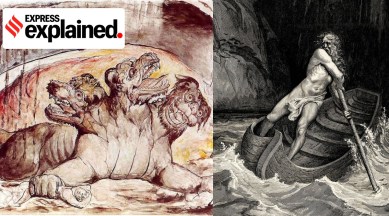Three-headed dog and ferryman to hell: Why Europe’s heat waves are getting Greek mythology monikers
The two heat waves that recently struck Europe have been named after Greek mythology figures, Cerberus and Charon. Although these monikers haven’t been coined by official weather agencies, their popularity has soared amid the rising temperatures across the continent.

As Europe continues to boil due to the arrival of two consecutive heat storms in the region within two weeks, the weather phenomena are acquiring names of Greek mythology figures.
Who were Cerberus and Charon?
Let’s first focus on Cerberus, a fearsome and tireless three-headed watchdog. A child of two monsters, Typhon (a deadly serpentine giant) and Echidna (a half-woman, half-snake), the dog was the foremost hound of hell and guardian of the underworld, according to Stephen Fry’s book, ‘Mythos: The Greek Myths Retold’.
Cerberus along with his sister Hydra, a gigantic water-snake-like monster, was picked by Hades, the god of the dead, to guard the entrances to hell. Describing the characteristics of the two monsters, Fry writes: “On the one hand, a dog with a more or less manageable three heads and an elegantly snaky tail to wag; and on the other, his sister, a many-headed water-beast who was almost impossible to kill.”
Notably, in the entire Greek mythology, only a handful of heroes could fool or circumvent Cerberus to visit Hades’ underworld and return safely to the world above.
Charon, the ferryman who delivered souls into the underworld, was the child of Erebus and Nyx — both were the creations of Chaos. Erebus, the son, was darkness and Nyx, the daughter, was night.
“The instant that human spirits departed their bodies, Hermes or Thanatos (the personification of Death) would lead them to the underground cavern where the River Styx (Hate) met the River Acheron (Woe). There the grim and silent Charon held out his hand to receive his payment for ferrying the souls across the Styx.
If the dead had no payment to offer they would have to wait on the bank a hundred years before the disobliging Charon consented to take them,” Fry writes in the book.
Why have the heat waves been named after them?
The name Cerberus for the heat wave that struck Europe earlier in July became popular after an Italian weather website, iLMeteo, specifically chose the name for an anticyclone in the region, according to a report by Wired magazine. Anticyclones are essentially high-pressure regions, which usually cause a heat wave or drought.
Although the Wired report didn’t point out why the heat wave was called Cerberus, a report by Yahoo News claimed that the weather phenomenon got the name as it related to three climatic zones that Italy will be divided into during the extreme heat.
“While temperatures right now in Italy are extremely high, in the north (which is dominated by the Alps) the mercury is only slightly above average. In the centre of the country, including Rome, temperatures are much higher than usual but are not the hottest. The worst of the effects are being felt on the Mediterranean Islands of Sicily and Sardina, as well as along the southern western coast of the mainland,” the report added.
Meanwhile, Charon is the name of the latest anticyclone, which came to southern Europe from north Africa. Much like in the case of the Cerberus heat wave, it remains unclear why exactly the new heat wave is being referred to as Charon. However, as heat waves are known to be, what scientists call them, the ‘silent killer’, Charon seems to be an appropriate name.
Is this the first time heat waves have been named?
No. iLMeteo, which called the July 10 anticyclone Cerberus, is well-known to name anticyclones after mythological figures. For instance, the website named the 2017 heat wave that hit Europe Lucifer — a name for the planet Venus in Roman mythology that was also used to refer to the devil in the Christian tradition, Wired reported. There are other institutions too which have recently started naming heat waves, including the US-based Adrienne Arsht-Rockefeller Foundation Resilience Center.
While some analysts say the growing trend of referring to heat waves or anticyclones by different mythology-based monikers might help in spreading more awareness about their dangers, others fear that it could desensitise people.
Hannah Cloke, professor of Hydrology at the University of Reading, told Wired: “We’re going to run out of dangerous monsters quite quickly… In the longer term, it’s not ideal.” She added that using simpler names, unlike Cerberus and Charon, could be more helpful in raising awareness and conveying that protective action is required.